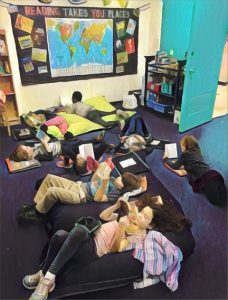Brooklyn mom, writer, and community organizer Orli Van Mourik shares her story of changing schools and finding the right fit for her spirited daughter. Thanks for sharing, Orli!
Recently I read an article that said archeologists have unearthed evidence that half of Viking warriors were women. To me, reading this news felt like confirmation. If you are someone who has trouble envisioning a member of the “gentler sex” donning armor and charging off to battle, teeth bared, voice high—well, then I invite you to spend some time at my house right around bedtime. My two daughters, you see, were built for battle. They are beautiful, fearless, fast, and ready to fight for what they want, whether that’s another episode of My Little Pony or freedom from the tyranny of basic oral hygiene. These days when I’m trying and failing to wrangle them into their PJs, I like to remind myself (in between deep breaths) that my daughters, like the Viking princesses before them, are wired to resist. And that now, more than ever, we need women capable of resistance.
I have bottomless admiration for my daughters’ fierceness, but parenting them is not always easy.
I have bottomless admiration for my daughters’ fierceness, but parenting them is not always easy. We don’t live in the wilds of Scandinavia in the 9th century after all. We live in modern day Brooklyn, a place where manners count. For this reason—and to preserve our own sanity—my husband and I have worked hard to graft on some twenty-first century manners. (We have a strict no spears policy.) The thing with having Viking warriors for children is that in a rush to “civilize” them you risk extinguishing their fire. At home, we do what we can to accommodate the girls’ intense, adventure-seeking natures. But when my eldest entered elementary school, it quickly became apparent that most public schools were not designed with kids like her in mind. When Maeve** wanted movement, her teachers wanted stillness. When she wanted contact, they wanted silence. When she wanted exploration, they wanted strictly focused attention. It didn’t take us long to notice that Maeve was coming home at the end of the day, not lit up with a love of learning, but with the defeated air of someone whose natural instincts are being thwarted at every turn. She was sad. She was bored. Unsurprisingly, she started getting into trouble.

Any parent who has a child who doesn’t fit the mold knows the special kind of agony my husband and I felt watching all this unfold. But we struggled over what to do. We hadn’t gone into the school thing blindly. In fact, we moved to our neighborhood in Cobble Hill specifically because it had one of the top rated public schools in the borough—a school that several people assured me was well equipped to handle kids with different learning needs. And, in defense of Maeve’s teachers, they did try. Most knew about the recent studies indicating that the ratio of instruction to physical activity in public elementary schools is less than ideal for learning. Nearly all agreed that social emotional development was as key for kids Maeve’s age as learning how to read. But the one-size-fits-all educational approach necessitated by Common Core standards and New York’s over crowded classrooms doesn’t leave a whole lot of room for outliers, no matter how good a teacher’s intentions.
We all want the same thing for our kids: we want them to get the skills they need to thrive in the world. At her public school, Maeve was meeting or exceeding all of her academic benchmarks, but she was far from thriving. In fact, she was wilting. After her second year there, we knew we needed to do something else, but what?
Maeve was meeting or exceeding all of her academic benchmarks, but she was far from thriving. In fact, she was wilting. After her second year there, we knew we needed to do something else, but what?
My husband and I are working artists. Private school wasn’t exactly in the budget. We also weren’t wild about the idea of sticking our kids in some rarified institution filled with people who looked and spoke just like them. We live in Brooklyn, in part, because it’s one of the increasingly rare places where you can still see the American melting pot in action. We wanted our girls to experience that. So when I signed up for a tour of The Co-op School in mid-2016, I did so more out of desperation than out of hope. According to the school’s website, its core values were “Compassion, Uniqueness, Innovation, Community Action, and Joy.” Yes—Joy! Who doesn’t want this for their child? But the truth was Maeve’s educational experience had already left me cynical. I expected to find something far less ideal on the ground.
The first thing I noticed when I arrived at The Co-op School’s Brevoort Campus was how much the location epitomized multi-cultural Brooklyn. Around the corner from the building there was a large mosque that amplified its daily prayers so they could be heard for blocks along Fulton’s bustling business district. The surrounding streets were filled with a remarkable range of faces: Black, Muslim, Latino, White. From the outside, the building looked like your typical brick and mortar institution, but as I watched the kids filter in, I noticed that each was greeted by name by the blonde woman standing at the front door, who later introduced herself as Meredith Gray, the head of the school. Why did this feel so different than Maeve’s current school, I asked myself? And then it hit me, the kids looked happy. Joy, I thought. Inside, the walls were papered with artwork and some parents sat huddled on a couch against the back wall, trading stories about the morning schlep. Despite its requisite Formica flooring and halogen lights, the whole place felt friendly and warm. Like a community.
Why did this feel so different than Maeve’s current school, I asked myself? And then it hit me, the kids looked happy. Joy, I thought.
I didn’t have to speak to Meredith very long to understand that The Co-op School is one of those rare organizations that walks the talk when it comes to its core values. We talked about Maeve’s struggles at her current school—her high spiritedness and unchecked curiosity. Meredith quickly filled me in on the school’s low student to teacher ratio and its two recess per day, no homework policy, adopted in accordance with the most recent scientific findings. (Innovation.) She emphasized their focus on the social emotional development of each child and told me about the resources available to kids who needed extra help. (Compassion.) There was also an evident respect for people’s inherent differences. (Uniqueness.) “We need tough girls,” Meredith told me as we were talking about Maeve. Yes, we do, I thought, feeling for the first time that a school administrator and I were actually speaking the same language.
I was given a tour of the school’s considerable amenities (library, craft room/wood shop, music room) and told all about its special programs (Spanish every day, reasonably priced/flexible after school care designed with working parents in mind). We talked about the necessity of integrated classrooms in shaping a better world, and the need to openly discuss issues like racism and sexism with children. She told me about the anti-bias curriculum the school had developed in 2014. Already in love with the place, I decided to be frank, “Money is an issue for us,” I told Meredith, certain this would be the end of the conversation. Surely, my family wouldn’t qualify for assistance.
A handful of weeks later my husband and I found out we’d been offered a spot at a rate that made it possible for us to send both girls. It turns out that The Co-op’s model allows it to be one of the most affordable private school options in Brooklyn. The model relies heavily on parent involvement. For some people this might have been a barrier to entry, but my husband and I welcomed the chance to get involved in a place that embodies so many of our values.
For the first time, she’s excited about school and eager to get there. If my husband and I have any regrets, it’s that it took us so long to find the right place for her.
Maeve and Betsy** started at The Co-Op School in the fall of 2016. Gone are the days of Maeve coming home, head sunk low after hours of being constantly scolded and, occasionally, even scorned. Her confidence, kindness and maturity are on full display these days. For the first time, she’s excited about school and eager to get there. If my husband and I have any regrets, it’s that it took us so long to find the right place for her. Her little sister is the lucky beneficiary of Maeve’s hard won experience. Betsy is starting her school career in a place that understands not just her special challenges, but also her special gifts. And if all this means I have to spend a few hours wiping down shelves or labeling books every couple months, it’s a small price to pay for my little Vikings’ joy, and for the opportunity to participate in a community that still holds a hopeful, inclusive vision for the world in a time when that has never been more sorely needed.
**Not their real names.
-Last photo is independent reading period at the Co-op School Library.
—–
Orli Van Mourik is a writer and a mom living in Bed Stuy Brooklyn. Her fiction and nonfiction has appeared in Joyland Magazine, Brain, Child, the Brooklyn Rail and Psychology Today. She teaches at the Sackett Street Writer’s Workshop and is currently at work on her first novel, Milkweed. Orli was one of the organizers of 2016’s Candlelight Vigil for Hope and Human Kindness at Fort Greene Park.
The Coop School accepts mid-year transfer students in the elementary school when space is available. To attend a tour, contact the Director, and find more information, go to www.coopschool.org. Application deadline for the preschool and elementary 2017 Fall school year is February 5th.
